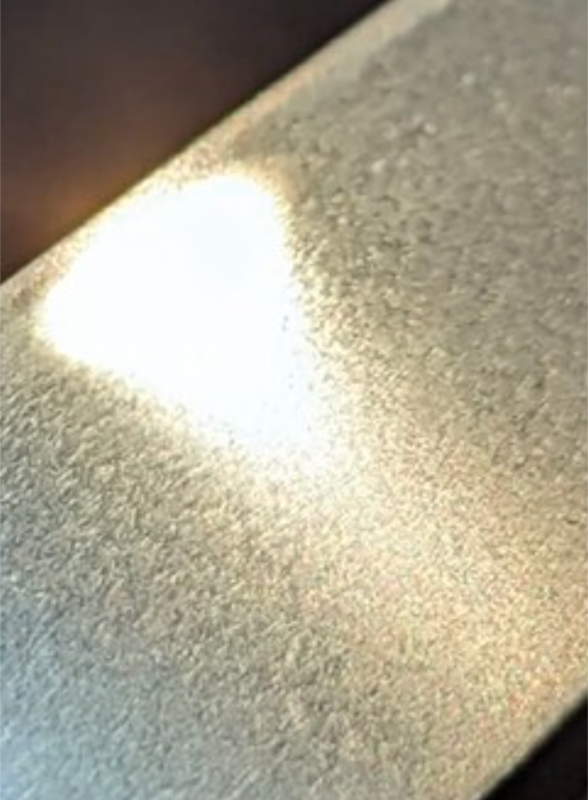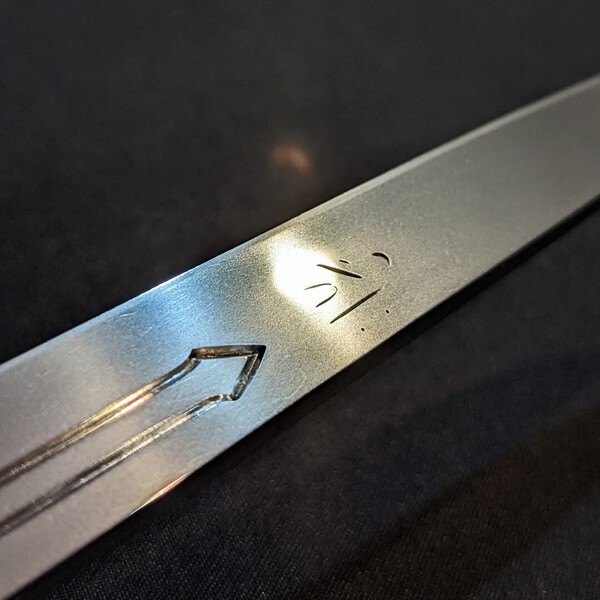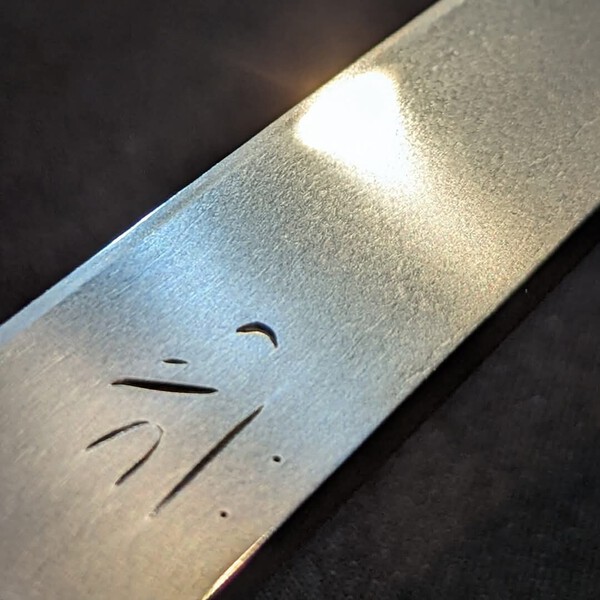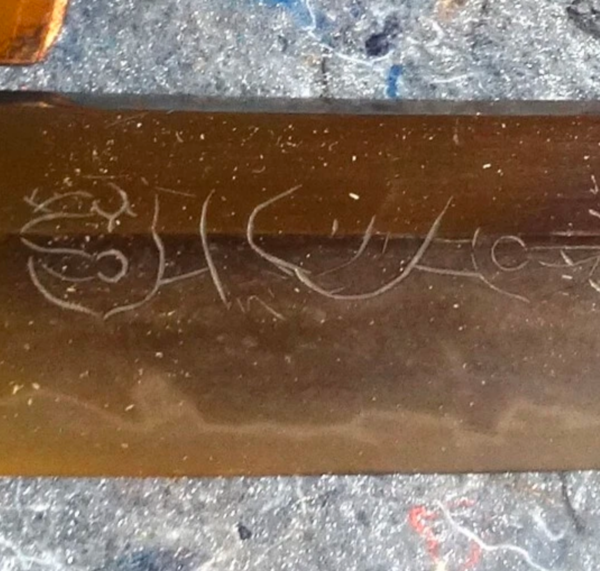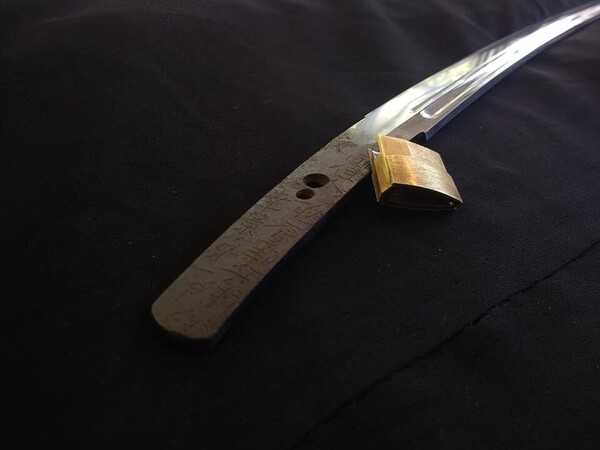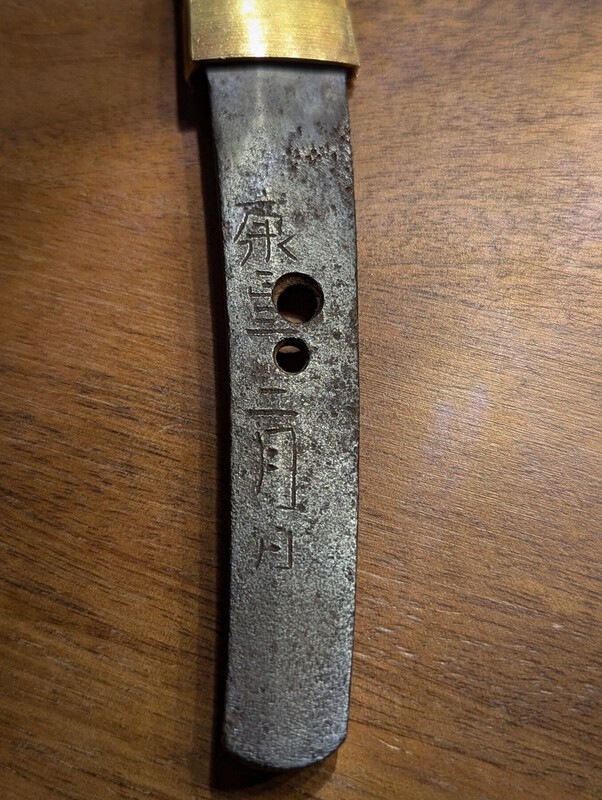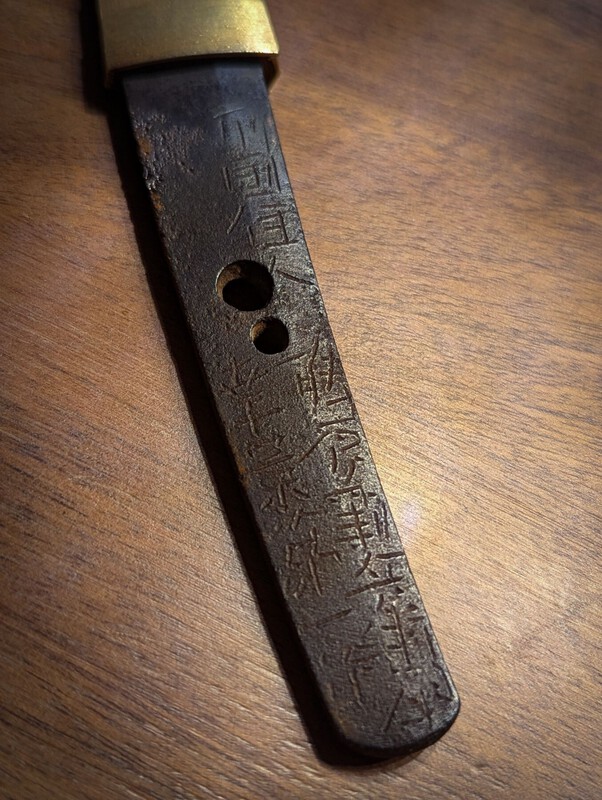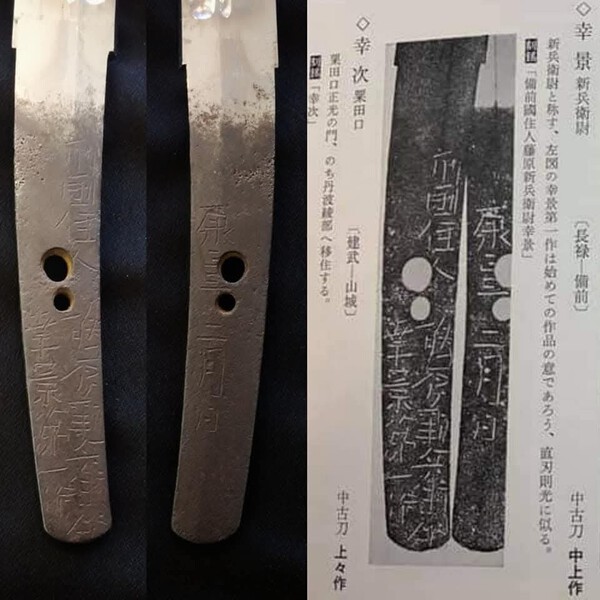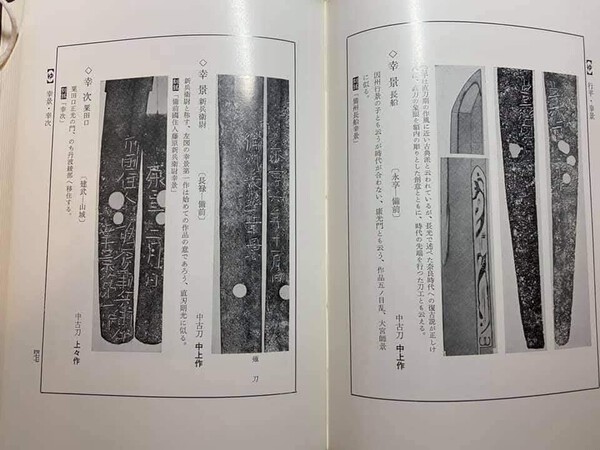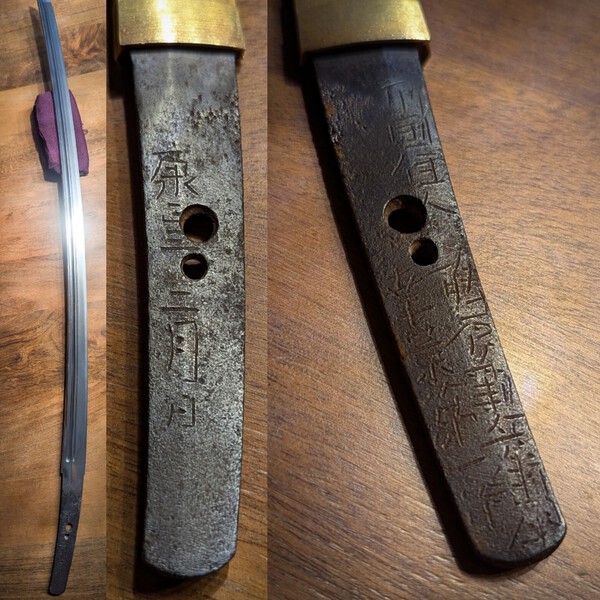-
Posts
5,163 -
Joined
-
Last visited
-
Days Won
139
Content Type
Profiles
Forums
Events
Store
Downloads
Gallery
Everything posted by Ray Singer
-
These are the small dark strands that appear on both sides of the glare, on the left and right. Keep in mind that this is a fairly narrow mihaba, so we were talking about a very small and fine features that measure around 2 to 3 mm each.
-
I have to rely on the photos that I already have on my mobile device at the moment, but please see attached. You will see a number of short, dark strands of connected nie within the jihada.
-
As far as your question about Awataguchi and nashiji-hada, they are several levels tighter and more compact than the sword that you photographed above. There will be a dense layer of bright ji-nie floating on the surface, and you will see small and fine chikei woven into the jihada (which also shows in the Shintogo photos above).
-
As an example of Yamashiro-den, this is one of the Shintogo Kunimitsu I own. Although he was called the founder of Soshu-den, Shintogo was said to have roots in the Awataguchi.
- 39 replies
-
- 10
-

-

-
The blade is in a new polish but it is not papered? What did the seller tell you? There's a limit to what we can say from a single detail photo like this, however honestly my guess would have been a Shinto Hizen-to. It may be helpful if you could tell us what you know about the sword and how was procured.
-
I believe it is: Bizen (no) kuni ju Katsumitsu
-

Original Old BIG Japanese Tachi Sword Signed Hamon Horimono
Ray Singer replied to Swords's topic in Translation Assistance
To be frank, I don't think it has much in the way of redeeming qualities that would make this a good restoration candidate. Not trying to insult your purchase, just being honest. Poorly executed horimono, gimei and potentially compromised boshi are all good reasons not to invest further. There are many many other legitimate swords out there that are healthy, with authentic mei (if signed), already polished and papered which are better pieces to consider for collecting. I'm sure that some polisher would accept it for restoration however you are unlikely to see your investment returned afterwards, and depending on the outcome the value may even decline. -

Original Old BIG Japanese Tachi Sword Signed Hamon Horimono
Ray Singer replied to Swords's topic in Translation Assistance
I see the original auction listing below. The horimono is very crudely carved, very doubtful this has been polished down over time, rather than being much more recent and shallow. The boshi looks like it may run off the edge at the midpoint in the kissaki. The saya also shows a recent and amateur painting ("restoration"). https://ebay.us/m/sv2tvd -

Original Old BIG Japanese Tachi Sword Signed Hamon Horimono
Ray Singer replied to Swords's topic in Translation Assistance
This one screenshot is not enough information to provide an assessment, but yes gimei reduces value (most especially compared with the value of an authentic example by a purported and famous swordsmith). It would be helpful to see clear, in-focus detail photos. -
Perhaps 兼英 - Kanehide.
-

Original Old BIG Japanese Tachi Sword Signed Hamon Horimono
Ray Singer replied to Swords's topic in Translation Assistance
The mei is Kunihiro. Poorly signed and little age to the nakago. Perhaps a gimei of Horikawa Kunihiro, on a fairly late blade, but there were many others who used that same name -

Recently (impulse) purchased tanto
Ray Singer replied to Coldramen's topic in General Nihonto Related Discussion
When the Tanto arrives see if it looks like this. 包宗作 -

Recently (impulse) purchased tanto
Ray Singer replied to Coldramen's topic in General Nihonto Related Discussion
Very difficult to see. Was the seller Komonjo? The mei might be Kanemune saku. -

Recently (impulse) purchased tanto
Ray Singer replied to Coldramen's topic in General Nihonto Related Discussion
The link is not resolving for me Either incorrect or removed. -
A fine Bizen Yukikage wakizashi with a deep sori and slender, graceful sugata that resembles a kodachi. Tokubetsu Hozon and published in the famous Fujishiro Toko Jiten. YUKIKAGE (幸景), Chōroku (長禄, 1457-1460), Bizen – “Bishū Osafune Yukikage” (備州長船幸景), “Bizen no Kuni-jūnin Fujiwara Shinbei no Jō Yukikage saku” (備前国住人藤原新兵衛尉幸景作), “Bishū Osafune Shinbei no Jō Yukikage” (備州長船新兵衛幸景), first name Shinbei (新兵衛), gunome-midare or suguha in nioi-deki, chūjō- saku - Markus Sesko $7,250.00 + shipping
- 1 reply
-
- 8
-

-

-

Translation of NTHK and Nakago
Ray Singer replied to bloodycarrots's topic in Translation Assistance
備中國呰部住爲家 - Bitchu (no) kuni Asabe ju Tameie. -
Do you have access to a clearer image? Perhaps Kaneharu (兼治). There were three Seki smiths signing Kaneharu during the war.
-
Yes an authentic antique Japanese sword and value is what a mumei Mino-den blade would be (perhaps a Sue-seki example).
-
Looks like you are squarely in Mino-Villa there (the blade shows characteristics of Mino-den work, with a togari-gunome hamon). This reinforces what we saw earlier with the mei, the deki (workmanship) is also not what we would expect to see for an authentic Tsuda Sukehiro.
-
It may still be quite a nice Japanese sword irrespective of the mei. You can see how common Sukehiro gimei are below. Regardless, we learn and move on... https://www.google.com/search?q="gimei"+"Sukehiro"+site%3Awww.militaria.co.za&client=ms-android-google&sca_esv=503182be980b3154&sxsrf=AE3TifPuM_Cw9A2sl6nSA8zgPznTvwTolg%3A1749081678794&ei=Tt5AaKqZMKb6wbkP8uiusAw&oq="gimei"+"Sukehiro"+site%3Awww.militaria.co.za&gs_lp=EhNtb2JpbGUtZ3dzLXdpei1zZXJwIisiZ2ltZWkiICJTdWtlaGlybyIgc2l0ZTp3d3cubWlsaXRhcmlhLmNvLnphSOUhUOAGWOEhcAJ4AZABAZgB1QGgAZYLqgEFMC45LjG4AQPIAQD4AQGYAgqgAuwJwgIKEAAYsAMY1gQYR8ICBRAhGKABwgIFECEYqwLCAgcQIRigARgKmAMA4gMFEgExIECIBgGQBgiSBwUyLjcuMaAHgxmyBwUwLjcuMbgH3AnCBwcwLjYuMy4xyAck&sclient=mobile-gws-wiz-serp
-
To authentic, you have the option to send to shinsa in Japan to evaluate for kanteisho (papers). Unfortunately my impression from seeing the mei and date is that this is not an authentic example of Sukehiro. Please attached for some reference examples.
-
The date is Enpo kyu nen hachi gatsu hi. A day in the 9th month of the year 1681.
-
It would be helpful to see a better, higher resolution image. The mei is Tsuda Echizen (no) kami Sukehiro. This is a very famous smith with many fakes.
-

Second mekugi ana at the end of nakago
Ray Singer replied to Rawa's topic in Military Swords of Japan
Shinobi-ana. https://www.google.com/search?q="shinobi-ana"+site%3Amilitaria.co.za&rlz=1C1YTUH_enUS1164US1164&oq="shinobi-ana"+site%3Amilitaria.co.za&gs_lcrp=EgZjaHJvbWUyBggAEEUYOTIHCAEQIRiPAjIHCAIQIRiPAjIHCAMQIRiPAtIBCDI0NDhqMGo3qAIAsAIA&sourceid=chrome&ie=UTF-8 -

Can someone please help me identify this sword.?
Ray Singer replied to NikkiK's topic in Translation Assistance
Yes, this is a showa era blade by the 23rd generation Seki Kanefusa. https://www.google.com/search?q=Seki+23rd+kanefusa+site%3Awww.militaria.co.za&client=ms-android-google&sca_esv=a919800cb6345d20&sxsrf=AE3TifPU7yf-CDYn22HMLRmOtiL6qHEU7Q%3A1748896200549&ei=yAk-aIiVIciqwbkP09OJ0QM&oq=Seki+23rd+kanefusa+site%3Awww.militaria.co.za&gs_lp=EhNtb2JpbGUtZ3dzLXdpei1zZXJwIitTZWtpIDIzcmQga2FuZWZ1c2Egc2l0ZTp3d3cubWlsaXRhcmlhLmNvLnphSOM0UKAPWPUncAB4AJABAJgBmAGgAacHqgEDMy41uAEDyAEA-AEBmAIAoAIAmAMAiAYBkgcAoAfoArIHALgHAMIHAMgHAA&sclient=mobile-gws-wiz-serp


